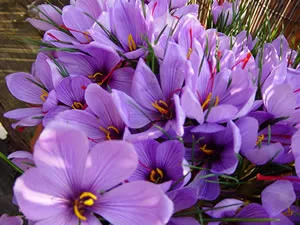 |
| Howthorn berries |
Hawthorn (Crataegus oxycantha) has
been used to treat heart disease as far back as the 1st century. By the
early 1800s, American doctors were using it to treat circulatory
disorders and respiratory illnesses. Traditionally, the berries were used to treat heart problems ranging from irregular heartbeat, high blood pressure, chest pain, hardening of the arteries, and heart failure. Today, the leaves and flowers are used medicinally, and there is good evidence that hawthorn can treat mild-to-moderate heart failure.
Plant Description:
Hawthorn is a common thorny shrub in the rose family that grows up to 5 feet tall on hillsides and in sunny wooded areas throughout the world. Its flowers bloom in May. They grow in small white, red, or pink clusters. Small berries, called haws, sprout after the flowers. They are usually red when ripe, but they may also be black. Hawthorn leaves are shiny and grow in a variety of shapes and sizes.
Hawthorn is a common thorny shrub in the rose family that grows up to 5 feet tall on hillsides and in sunny wooded areas throughout the world. Its flowers bloom in May. They grow in small white, red, or pink clusters. Small berries, called haws, sprout after the flowers. They are usually red when ripe, but they may also be black. Hawthorn leaves are shiny and grow in a variety of shapes and sizes.

Animal and laboratory studies report hawthorn contains antioxidants, including oligomeric procyandins (OPCs, also found in grapes) and quercetin. Antioxidants are substances that destroy free radicals -- compounds in the body that damage cell membranes, tamper with DNA, and even cause cell death. Free radicals occur naturally in the body and grow in number as we age. Environmental toxins (including ultraviolet light, radiation, smoking, some medicines, and air pollution) can also increase the number of these damaging particles. Free radicals are believed to contribute to the aging process (such as wrinkling) as well as the development of a number of health problems including cancer and heart disease. Antioxidants found in hawthorn may help stop some of the damage from free radicals, especially when it comes to heart disease.
Hawthorn contains many substances that may benefit the heart. These antioxidant flavonoids -- including OPCs -- may help dilate blood vessels, improve blood flow, and protect the blood vessels from damage.
The Hawthorn berries, leaves, and flowers of the hawthorn plant have been used for medicinal purposes. Most modern preparations use the leaves and flowers, which are believed to contain more of the flavonoids than the berries.
Hawthorn fruit is used to help protect against heart disease and help control high blood pressure and high cholesterol.
Heart failure
Hawthorn has been widely studied in people with heart failure (a condition in which the heart is unable to pump enough blood to other organs in the body). A number of studies conclude that hawthorn significantly improved heart function. Studies also have found that the herb can improve the ability to exercise in a person with heart failure. Participants in studies have reported that hawthorn significantly improved symptoms of the disease (such as shortness of breath and fatigue). One study found that hawthorn extract (900 mg/day) taken for 2 months was as effective as low doses of captopril (a prescription heart medication) in improving symptoms of heart failure.
A large study found that a standardized hawthorn supplement was effective in 952 patients with heart failure. The study compared conventional methods of treating heart failure (with different medications) with hawthorn alone and in addition to the drugs. After 2 years, the clinical symptoms of heart failure (palpitations, breathing problems, and fatigue) decreased significantly in the patients taking the hawthorn supplement. People taking hawthorn also took less medications for their condition.
Heart failure is a serious condition, and you should never try to self-treat with hawthorn. Ask your doctor if hawthorn is right for you.
Chest pain (Angina)
Some preliminary evidence suggests hawthorn may help combat chest pain (angina), which is caused by low blood flow to the heart. In one early study, 60 people with angina were given either 180 mg/day of hawthorn berry-leaf-flower extract or placebo for 3 weeks. Those who received hawthorn experienced improved blood flow to the heart and were also able to exercise for longer periods of time without suffering from chest pain. However, more studies would be needed to say for sure whether hawthorn was effective.
High blood pressure
Although hawthorn has not been studied specifically in people with high blood pressure, some people think that its benefits in treating heart disease may carry over to treating high blood pressure (hypertension). However, so far not enough research has been done to say whether hawthorn is effective at lowering blood pressure -- and if so, by how much.
In one study, a hawthorn extract was found to be effective for hypertension in people with type 2 diabetes who were also taking their prescribed medicines. Participants took 1,200 mg hawthorn extract daily or placebo for 16 weeks. Those taking hawthorn had lower blood pressures than those taking the placebo.
You should talk with your doctor before taking hawthorn if you have high blood pressure.
Available Forms:
Hawthorn is available in non-standardized and standardized capsules and liquid extracts, along with tinctures and solid extracts. A bitter-tasting tea can also be made from dried hawthorn leaves, flowers, and berries. Howthron capsules are also available in your local store.
Hawthorn is available in non-standardized and standardized capsules and liquid extracts, along with tinctures and solid extracts. A bitter-tasting tea can also be made from dried hawthorn leaves, flowers, and berries. Howthron capsules are also available in your local store.
"Ginkgo House", Nambalbal, Azizabad, Via Wuyan-Meej Rd.Pampore
PPR JK 192121
R&D Units in : Sonamarag, Kishtwar, Ramban & Tangmarag
Mailing address: PO Box 667 Srinagar SGR J&K- 190001
Call us: 09858986794
Ph: 01933-223705
e.mail:jkmpic@gmail.com
web: http://jkmpic.blogspot.com



